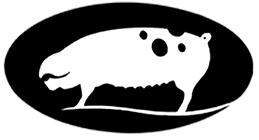THE GLOUCESTERSHIRE OLD SPOTS PIG
(or GOS Pig for short), descended from a region in Gloucestershire, England known as the Vale of Berkeley. Recognized as the oldest pedigree spotted pig in the world, the GOS was once popular with small family farms, where they were raised on dairy by-products (such as whey) and orchard “drop fruit,” giving these pigs the nicknames “cottage pig” and “orchard pig.”
Like many breeds originating before the 20th century, the exact history and composition of the Old Spots pig is unknown. The most likely origin is a pairing of the original Gloucestershire pig (a large off-white pig with floppy ears and wattles) and the unimproved Berkshire (a sandy colored pig with prick ears and black spots). One other notable contributor is the Lincolnshire Curley Coat, a pig that has since gone extinct. The Old Spots is also genetically and characteristically similar to the extinct Cumberland pig and is presently being used in its recreation in the UK. These breeds were regarded as thrifty and excellent foragers, supplementing their feed with roots and vegetation. Additional commonalities among these breeds include excellent maternal instincts and even temperament.
The GOS remains remarkably hardy today. They can withstand harsh weather and adverse conditions. This is in part due to the breed’s higher body fat ratio. Once revered for this high-fat yield, the GOS served as an important producer of flavorful meats, lard and bristle hair. It was with the shift in dietary trends, as people began replacing much of their animal fat intake with vegetable fat, that the demand for lard-producing pigs decreased. This dietary shift, coupled with the Post WWII industrialization of agriculture, led to the decline in GOS numbers. Farmers were less interested in self-sufficient grazing breeds than they were in breeds easily kept indoors.
Unfortunately in the pursuit of efficient, industry-compatible hybrids, many commercial sows lost the maternal instincts native to their purebred ancestors. The GOS, noted for their exceptional mothering, was occasionally introduced into large pig operations in an effort to recreate this vital instinct. However, this niche alone could not keep the GOS numbers from all but disappearing.
